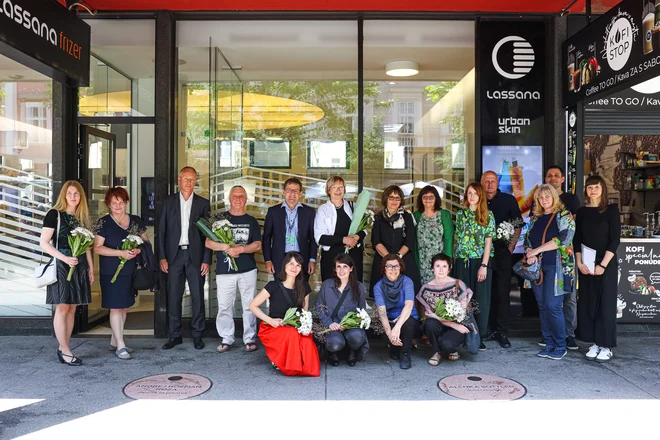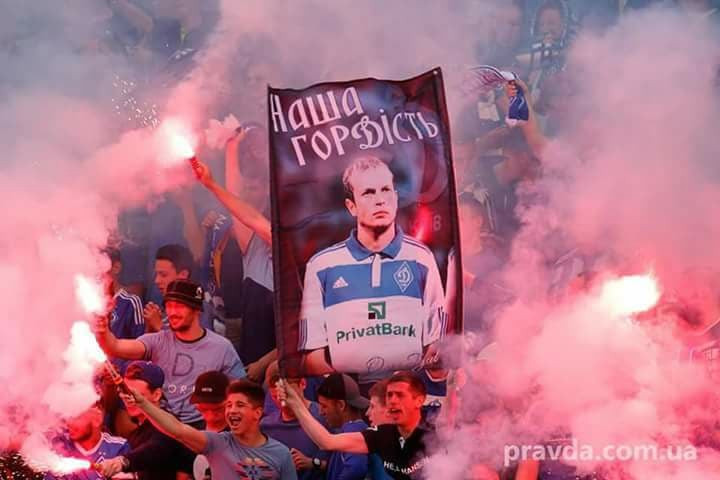The premises of meeting, arrivals and departures
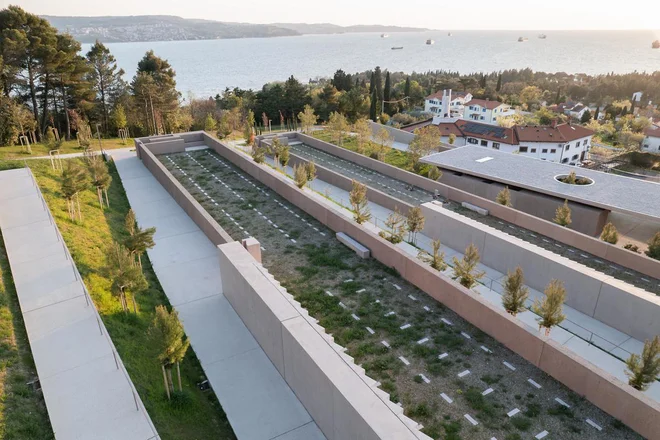
Ankaran Cemetery is the central award winner of this year’s Plečnik Awards. As the decision was founded by an expert jury, « the list of authors for the criterion and specifics of the location opened the possibility of multifaceted architectural work, from which we can see another important feature. Particular attention is paid to the material that responds with its texture and color to the importance of the place. «
The jury wrote at the Plečnik Award for the public space that « the division of a single cemetery space into several parts, so that individual grave fields are immersed in the surrounding forest, opens the possibility of interweaving the forest landscape with the premises of the graves, which subtly activates the potential of public space and protects it at the same time, offering users a park arrangement. »
The design, in their words, shows the excellent mastery of the vertical collection of the area, which, with the simple design of interconnected terraces, resolves altitude passage and connection to the surroundings at the same time. The park character of the cemetery and the attachment on forest paths innovatively address the direct broader context. At the same time, the wider landscape space and exposed contact with the horizon and sky of the user direct the user to contemplate and in -depth experience of the world and space. The new arrangement is successfully placed in the context of the landscape with the planting design, Aleppo pine and cypress, and adds symbolic meanings in the cemetery.
This year, 42 projects that have been created in the last three years have been received, most (12) in the smaller criteria realization category. Plečnik’s medal in the category of realization of the larger criteria was received by the authors of the Bohinj kindergarten, and in the smaller criteria the authors of the revitalization of the old glass and Vraz Square in Ptuj received the authors of the smaller criteria. The jury emphasized that all three awarded works are the result of public competitions and public investments of local communities, which again proves that the condition for quality architecture are the professional choice of the best solution and a transparent procurement process.
« The high quality of all this year’s proposals reports that even today, even today, great social crises are emerging and realizing architectural ideas of large and small criteria that find new ways to connect space and people, contributing significantly to finding answers to the deepest questions of human existence, » he read in justification. Until 8 June, the award -winning works will be presented through the basic idea of the project at Plečnik House on Karunova 4 in Ljubljana. In recent months and years, the stories of all three award -winning projects have already been presented in more detail on the Delo Ambient pages.
Plečnik Award
In the Public Space category: Ankaran Cemetery
Uroš Rustja, Primož Žitnik, Mina Hiršman, Mateo Zonta (architecture) and Ana Kučan, Luka Javornik, Danijel Mohorič (Landscape Architecture)
The cemetery, to which the local community has been waiting for two decades, also lives as a public park with views of the Bay of Trieste and in connection with forest paths. The broadest public was included in the project, even if the fate of this space, which was also privately owned and intended for tourism, could turn differently.
The Ankaran Cemetery also lives as a public park with views of the Gulf of Trieste and in connection with forest paths. Photo: Ana Skobe
A key feature, inseparable intertwining of the landscape and architectural design on key elements, such as orientation, materiality and symbolic expression, has already set a competition task. According to the landscape architect Ana Kucan, it was the hardest to combine the modern model of the cemetery with traditional. Due to the restrictions of the space, the idea of fencing only the grave fields was fenced off, reinterpreting the traditional walled cemeteries, while opening the cemetery into the everyday life of the place as a public park, as a place of reputation, memory, contemplation, which is not separated from the life of the place.
The red thread is the organization of space on the central ritual path through five terraces that lay down the slope. The ritual route begins on the square in front of the cemetery, leads through a farewell facility and is serpentine between terraces with tomb fields, which makes the visitor experiencing the cemetery space sequential, in exchanging views from forest to the sea, from darkness to light. The spatial dramaturgy of the visitor is also constantly embedded in a broader spatial context.
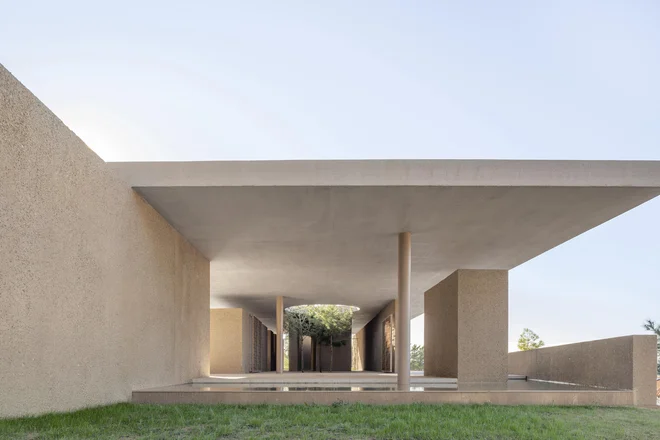
The Ankaran Cemetery is a multifaceted architectural work, where special attention is also paid to the material that responds to the importance of the place with its texture and color. Photo: Ana Skobe
With the involvement of the cemetery in public paths, they responded to the removal of deaths from the consciousness of the individual and the community, and set the possibility that the cemetery act as a community space. At the same time, they sought to set a new model in terms of more sustainable regulation of practical aspects of the cemetery infrastructure, as well as by consciously abandoning imported rocks, plastic tombstones and flowers. They suggested that tombstones are unified in the Karst limestone, which is the material of traditional Mediterranean cemeteries.
According to architect Uroš Rust, it was also necessary to keep in mind that this must also be a place of individual saying goodbye, mourning, memory, contemplation. The double design of this space, on the one hand, is manifested as openness, and on the other, as introverting and facilitating memory and reputation in contemplative. Next year, a connecting footpath with a settlement on the north side of the cemetery will be arranged.
Plečnik’s medal
In the category of architectural realization of larger criteria: Bohinj Kindergarten
Ana Jerman, Janja Susnjar, Sofía Romeo Gurrea-Nozaleda and Miguel Sotos Fernández-Zúñiga (architecture) and Luka Javornik and Lara Gligić (Landscape Architecture)
When designing a kindergarten with eleven casinos, kitchen and dental clinic the authors tried to consider the characteristics of the natural and local environment as much as possible, which also emphasized the competition. The basic guiding principle was that there was a lot to grow from a small age, which not only relates to children but also to kindergarten. The authors also followed what they would like as children in kindergarten from play and exploration to hiding and observing the surroundings.
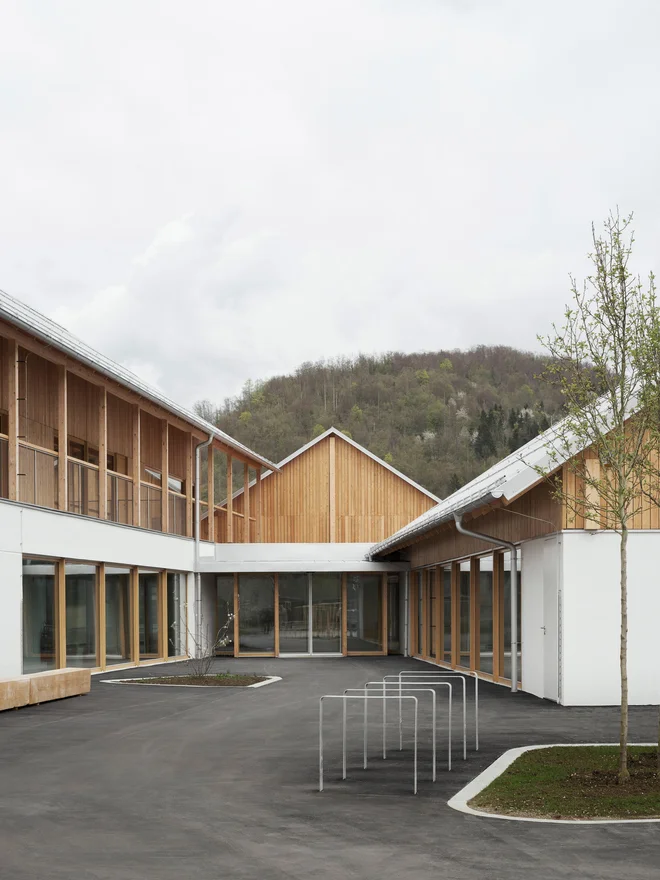
The Bohinj Kindergarten consists of three houses, and their construction used local architectural elements and materials, mostly wood. Photo: Luis Diaz Diaz
The building consists of three houses, and their construction used local architectural elements and materials, mostly wood. The house has a yard and a typical gank, and all communication in the new facility is planned according to the principle of an open and closed corridor to which transverse casinos are oriented.
The houses connect the inner common yard, « the place of meeting, events, arrivals and departures. » The smallest is a gym intended for a joint play of children, and in the afternoon it can also act as a separate community facility. The second, ground floor house has rooms for younger children, in the end there is a summer casino that opens to the landscape and allows play, even when it rains, which is very common in Bohinj.
In the adjacent, largest, two -storey building, just steps away from the elementary school dr. John Mencinger, is the kingdom of the greatest gardeners. Their views not only reach the school, which is also designed in several arms, but open to the market, the church nearby and the wider Bohinj space. On the ground floor of this house there are also service facilities, premises for professionals and janitor, chamber, office, kitchen and dental practice. Everyone is opening up to the market so that the child can observe how everyday processes are going on, and they learn from it.

In Bohinj Kindergarten, the ambience is a single common playing area. Photo: Luis Diaz
All casinos connect with each other. They can combine two or the whole house into a single continuous space where children can run, circulate and play freely. Thus, all kindergarten can become a common playing surface. The casinos open to both the inner hallway and the outdoor terrace or gank on the floor, which represent a more intimate space of the wider outdoor space. An open, transparent and focused playground, which is also sufficiently broken down for exploration, different experiences and niches for a more intimate game, is a continuation of the orchard who was on the lawn before the kindergarten grew. All rooms provide beautiful views of the surroundings and the Bohinj mountains, another of the important starting points of the architectural design.
Plečnik’s medal
In the category of architectural realization of smaller criteria:
Revitalization
Matevž Zalar, Ambroz Bartol, Dominik Košak, Miha Munda, Rok Staudacher and Samo Kralj (Architecture) and Darja Matjašec, Pia Kante and Katja Mali (Landscape Architecture)
The purpose of renovating the building heritage and the use of these spaces in the center of the city was to establish new cultural programs and to provide even greater connection with cultural and festival activities in the city. Through the project, young people have acquired a new creative center, where many activities have been gained in recent years, here the first experience has been acquired by well -known Slovenian players and other culturalists.
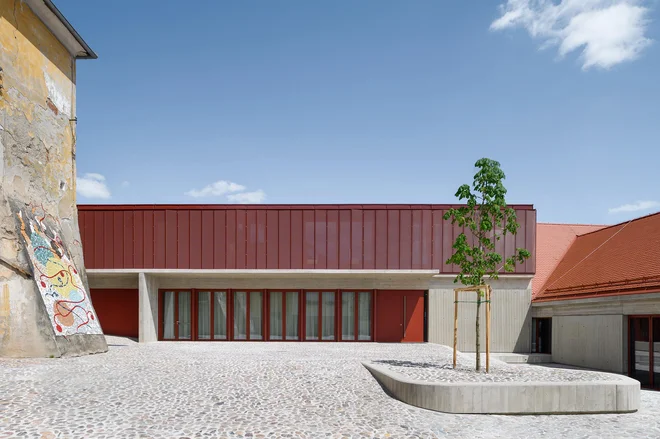
Through the simple design of the revitalization of the old glass and Vraz market, the architects tried to create a dialogue between the past and the present. Photo: Miran Kambic
Vrazov Square is now the intersection of cultural events in Ptuj and an important urban move in the old town, and the glass yard is more intimate spacewhich, with large cantilevered doors, can be completely opened into the street and transformed into one of the city markets. With the renovation, the market was also given a side open space, which was previously a transition area between Vrazov Square and Aškerčeva Street.
Through simple design, the architects tried to create a dialogue between the past and the present, both in terms of utilitarian and design and software upgrades of the existing one. The new wall is as a movement role through the premises and at the same time a mediator between the outdoor spaces of the streets, lanes and yards and the interior spaces of the cultural center. All walls are connected to a clearly accentuated horizontal wreath that flows along the stroke of the entire roof.
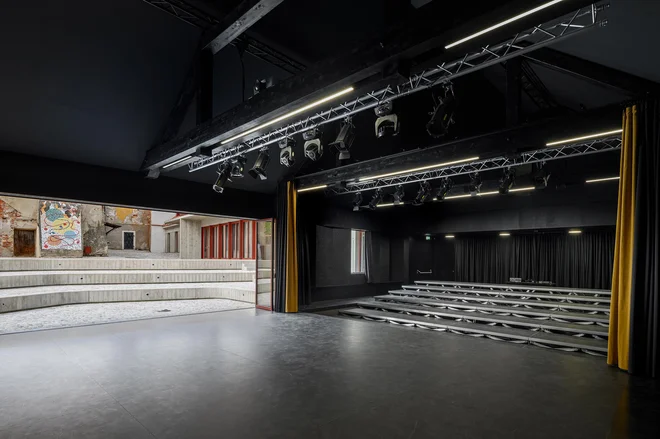
With the project in the old part of Ptuj, young people have acquired a new creative center, where numerous activities have been organized over the years. Photo: Miran Kambic
During the construction, they discovered, among other things, the wells, which are now presented as part of the external arrangement, and also encountered many Drava pebbles or cat heads that once paved the entire old town. These pebbles were used in paving the facility and nearby streets and markets.
The outer perimeter of the former iceberries is today part of the main staircase of the cultural center. Inside, the Old Glassworks facility has acquired new premises and halls that are adapted to amateur culture. Small and large halls can be fully open on various occasions and connect through an external auditorium with a yard or entry market, and all the stage technique can be used there. In the Great Hall, the event space with the rise stage can be adapted to very different purposes, as well as the training facilities in the attic can be combined into larger units.
The revitalization of the old glass and Vraz market in Ptuj was already awarded in 2023 with the Piranesi Award.
ostale rewards
Plečnik’s medal
To enrich the spatial culture
Landezine platform, ZAŠ Brezar
Plečnik Medal for Professional Publicism:
Between History, Ideologies and Conflicts, Architecture in Slovenia 1968–1991, Raimondo Mercadante
Plečnik Fund Scholarship:
Right to Railway: The conceptual design of the revitalization of railway facilities in Baška grapa, Master’s thesis 2024, Elvis Jerkic

